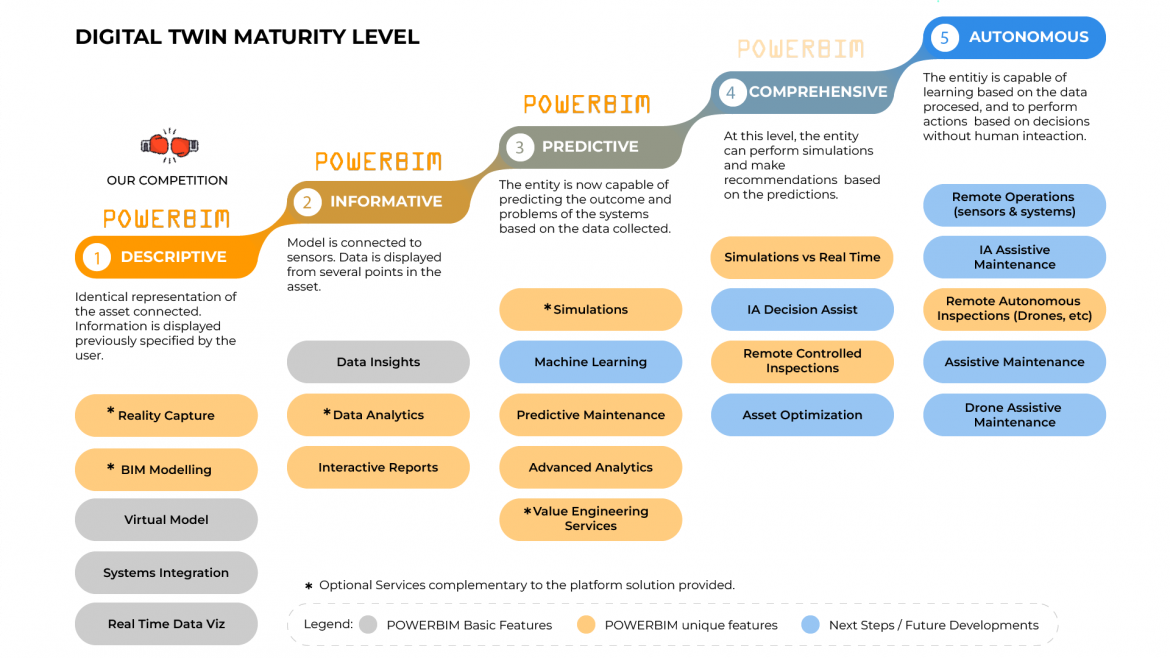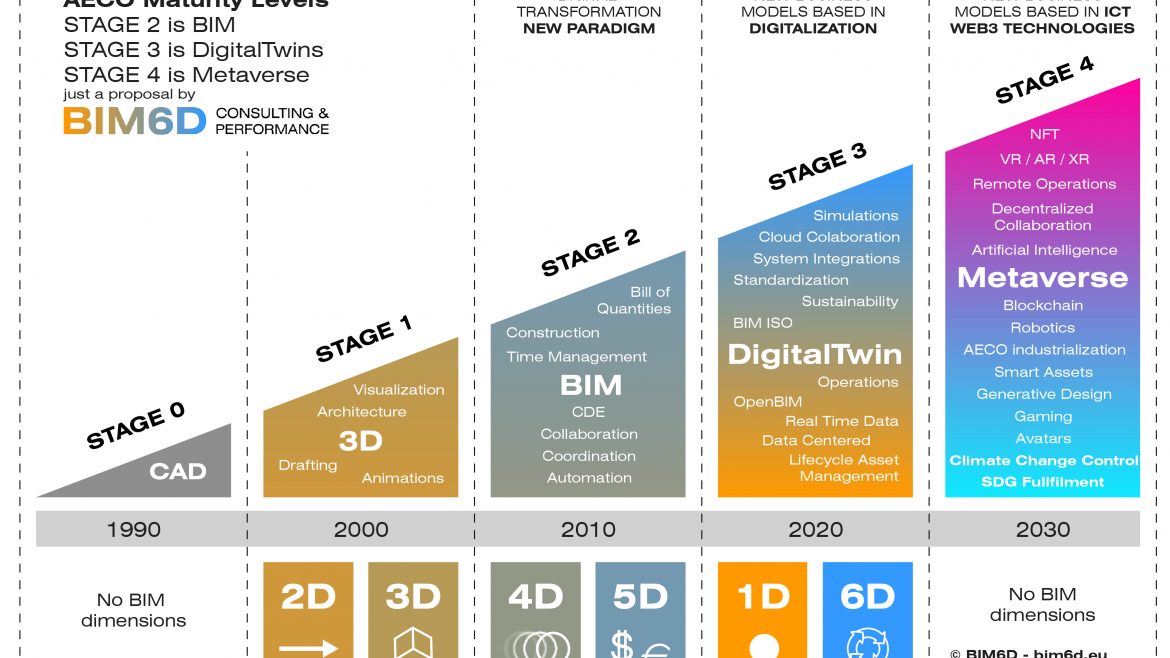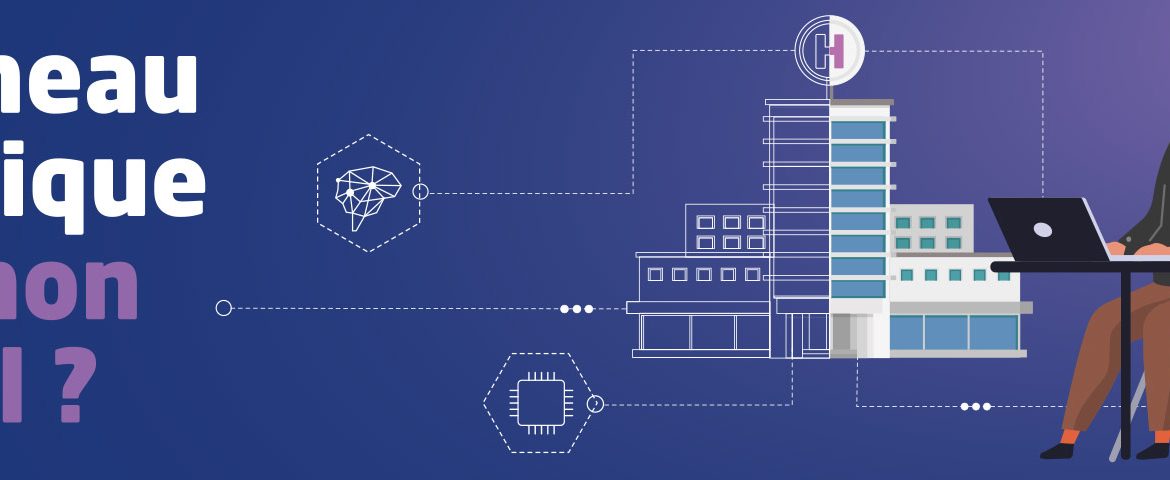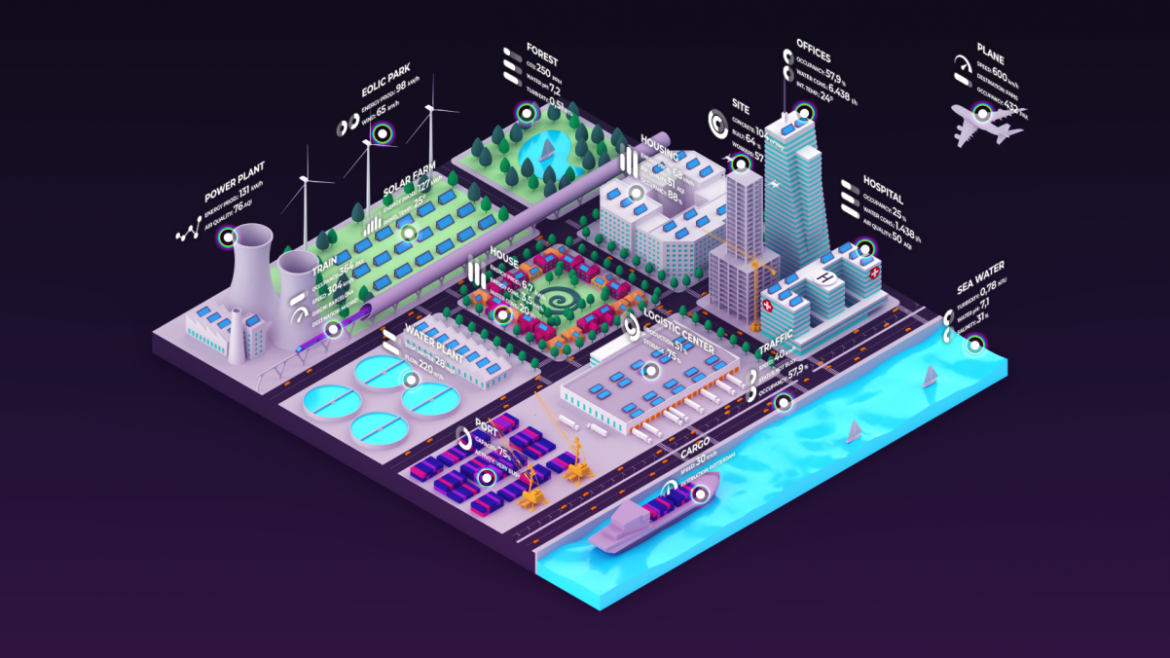DIGITALTWIN MATURITY FOR BUILDINGS, INFRASTRUCTURES AND CITIES
Empowering the Future: Navigating the Landscape of Digital Twin Maturity with POWERBIM
Author: Fernando Morales
In this exploration of digital twin maturity, our journey with POWERBIM unfolds as a testament to the evolving landscape of technology.Positioned at the forefront, we transcend industry expectations, harnessing a unique blend of cutting-edge functionalities. From automated audits to real-time simulations, our platform pioneers the integration of vital dimensions, offering a comprehensive solution poised to shape the future of digital twins in our sector.
With a focus on the nuanced interplay of gray and orange facets shown in the infographic, we strive not only to meet but exceed the evolving needs, providing a robust foundation for the next era of digital twin innovation.
DIGITALTWIN MATURITY FOR BUILDINGS, INFRASTRUCTURES AND CITIES
The chart below aims to explore the technological maturity level of digitaltwin development, so that we have a classification capability for solutions that are currently presented as digital twins.
I have conducted this analysis based on various sources discussing the concept, while also contributing my own perspective that applies to the management of buildings, infrastructure, and cities – assets for which our POWERBIM platform provides a digital ecosystem-based solution.
I believe that this type of analysis, while there is not yet a standard definition, is necessary for various reasons:
- By defining the maturity level of a solution labeled as a digitaltwin, we will clearly determine whether this solution provides technological value for the objectives that the digitaltwin is supposed to have.
- A digitaltwin is an ecosystem of integrated technologies that should automate processes for specific use cases. Depending on the technologies that a solution can integrate, the solution is more or less mature.
- There are no two identical digitaltwin solutions, and there is much confusion about it because simply saying “digitaltwin” is not very informative. I believe that we should start classifying these solutions based on certain aspects. The chart below may be somewhat general, but it allows for positioning solutions as either less mature or highly mature.
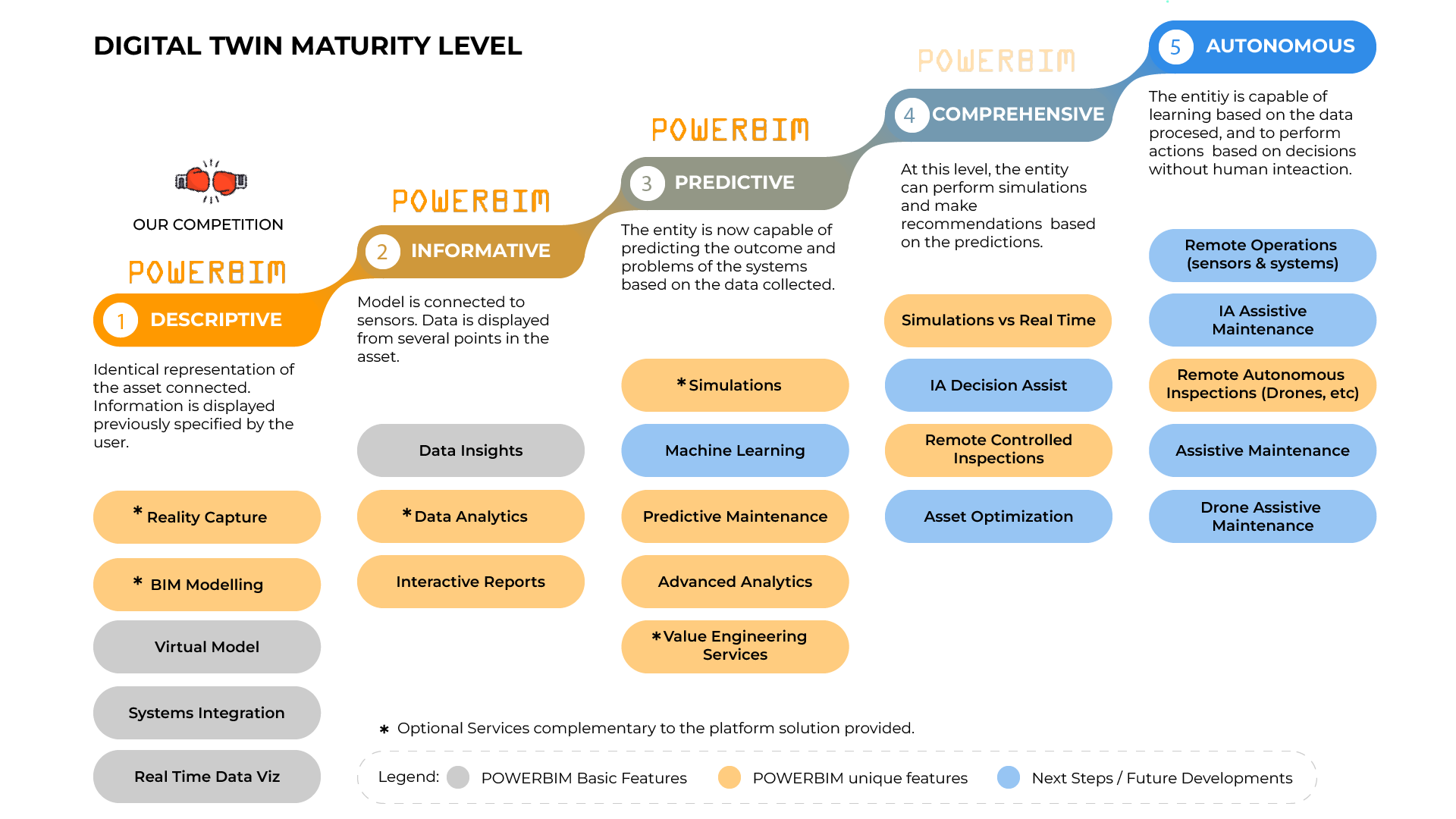
The chart displays colors in the cells, and these colors represent three types of technologies/services that digital twins should include, based on our vision and experience with POWERBIM, as well as the analysis of the competition:
- Gray: Represents technologies or services that are assumed to be minimal or foundational for a digitaltwin, present in almost all platforms self-identified as digital twins, typically in a less mature or preliminary state.
- Orange: Moving into our sector, these represent technologies or services that a mature digital twin should have. This is essential for considering a solution as truly mature and capable of deploying a range of use cases that contribute real value.
POWERBIM incorporates functionalities and services for all the elements marked in gray and orange in a unique way, with little competition. Beyond integrating or visualizing data, the digital twin should be used to solve process problems, and for that, we need to be able to generate advanced analytics and simulations.
- Blue: Represents functionalities or processes that should be incorporated from today into the nearest future to be able to talk about the autonomous digital twin. This involves incorporating artificial intelligence as just another service available for use cases. The aim is to autonomously determine the best arrangement of variables based on simulations to solve complex problems more efficiently than a human team. It should be capable of acting on systems with critical failures, transmitting results, communicating in natural language with operators, or even controlling devices such as rovers, drones, mechanical arms, and perhaps not too distant in the future, fully functional robots.
The future of digitaltwins is promising, and each sector will need to address its evolution differently, but with common aspects related to how artificial intelligence will convey information to humans and the actions it can exert on the systems it controls.
Going upstairs to achieve fully matured digitaltwins, POWERBIM is positioned in the middle of the journey, surpassing solutions that are presumed to be highly advanced from major technological entities. With our five years of development, we understand that the digitaltwin has much more room to evolve. However, in our case, with the current integrated technologies applied correctly, we can already enhance and optimize the primary use cases that we classify according to the so-called BIM dimensions:
1D – Automated audit and compliance with standards/regulations
2D – Document management, integration of documents and files linked to assets
3D – Analytics of static data derived from the digital model (BIM/GIS)
4D – Management of temporal processes (planning, warranties, etc.)
5D – Integrated management of measurements and budgets within the digital twin
6D – Simulations, real-time data from integrated management systems, machine learning, and predictive analysis
Final reflections
This chart is not an exhaustive study that incorporates all aspects to consider for the development of a mature digital twin in our sector. It is merely a general approach and requires further development to delve into the details, perhaps necessary to create, as an objective, a specific list of requirements that the digital twin for our sector should have. However, in our case, with the POWERBIM platform, we believe that the gray and orange cells, with all the nuances we may consider, provide a substantial approximation.
BIM Level 4 of Maturity in AECO is Metaverse
A DECLARATION OF A NEW LEVEL OF MATURITY FOR AECO SECTOR, AND IT IS NOT BIM
Author: Fernando Morales
In 2011 the Government Construction Strategy of the United Kingdom mandated the use of Level 2 Building Information Modeling (BIM) on all public sector projects by 2016. This bold decision led to the government and the construction industry working together to develop the industry’s skills, standards and tools to dramatically reduce the cost of social infrastructure. In 2019, a graphic created by Jacek Katzer talking about BIM levels has been publicated, and soon a new version will be adopted globally to represent BIM maturity Levels, including a futuristic Level 3.
We today want to propose a new graphic version, redefining Level 3 in where we are inmersed, and creating a new Level 4 to come in the future, but being shaped fast by main technological companies, Metaverse will impact in AECO for sure, and it is Level 4 of maturity.
BIM Maturity Levels - Today
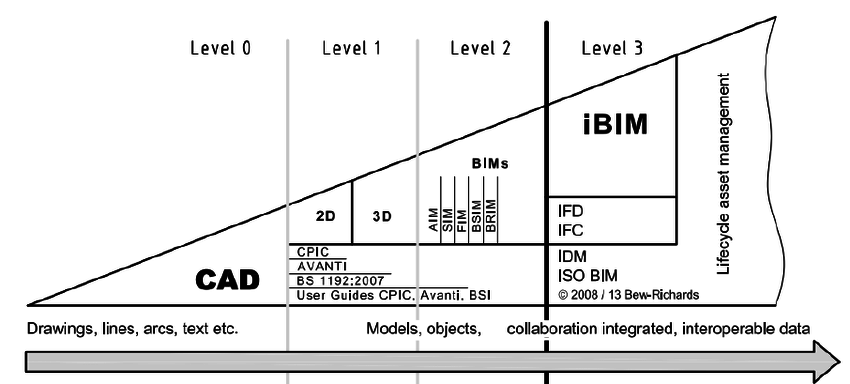
The UK Code for BIM defined the maturity levels as shown in image above. It can be concluded that the levels start from no collaborative environment (level 0) to an open collaboration level. It reflected the future improvement in collaborative tools, which would be affected by the construction sector. Moreover, new levels of BIM maturity were expected to continue updating in the future. (we are proposing the Level 4)
- Level 0: This is the primary level which includes 2D CAD (Computer Aided Design tools) for drafting and its output is simply distributed along the parties via paper or electronic prints. In this stage, there is no combination of any BIM enabling software.
- Level 1: This is a combination of 3D CAD models and 2D drafting documents with information about the product. This represents the current level for most organizations that are involved in the construction The collaboration is increased within the internal departments of the organization itself and 3D CAD models are more common. The attachment of data representing different sides of the project with lower model and 2D drawings are mostly used for documentation of work and production of shop drawings.
- Level 2: This is a level which operated by collaborative practices. Each participant in this level is working on his own 3D model. It comprises the sharing of data through common file formats like Industry Foundation Classes (IFC) and Construction Operations Building Information Exchange (COBie). Therefore, each party is entitled to use any type of BIM software on the condition that it is interoperable with the formats agreed upon for information exchange purpose.
- Level 3: This level uses a full collaborative process with a single shared model. It represents the future of collaboration among different construction stakeholders and throughout all the construction processes and This allows all parties to access the project. Paperless project based on the ‘cloud-based’ data will be extended to the execution of the project where rugged tabs replace the conventional shop drawings. This allows the risks to be reduced by reducing the conflict of information.
More than BIM for our sector, crossing with others

But for us, Level 3 is much more than a cloud based collaboration in a fully integrated environment, it is about a new paradigm appearing called DIGITALTWIN (see our conceptualization of this technology in this POST)
So for us Level 3 is not only BIM in a better maturity level, it is related to BIM integrated to other ICT technologies based in Data, Cloud Computing, Simulations, Advanced Analytics, all intented to improve Asset Management in a Lifecycle approach for first time.
IoT technology is getting mature and real time data is helping to obtain better results than MEP or Structural Calculations, so Simulations can be calibrated, improved in order to obtain more accurated results and being able to anticipate to the problems if we create comparison between real time data and expected results.
Digital models, BIM models but also 3D or GIS are helping us today to contextualize the data and to be able to provide and added value to ICT technologies that are growing fasts and being incorporated by more and more companies and organizations.
So we need to create new ecosystems in AECO that take the best of Level 2 to interact to Data Science, a Cyberphysical environment in where sensors, machines, systems and software are linked, thanks to edge and cloud computing, and this much more than a CDE, so CDE was not intented to support BigData, in that case a part of the information is managed in DataLakes or Data Warehouses and CDE is structuring the General Asset Information to be able to create new relationships with non BIM data sources.
The more important is the usability of DigitalTwins, this technology is really intended to improve Asset indicators, like Energy, Sustainability, Cost Management and others.
Note that Level 3 is a big opportunity to obtain return of investment for BIM projects, using digitalmodels more than to deliver projects for construction, we are evolving to find new business models for new opportunities to grow in the sector and crossing with others, and this is just the beginning…
But a More Big one is coming, Level 4 is Metaverse, in the upcoming years we will see how the web is going to change to a new way to understand human relationships for all sectors, fast and in a very impressive way.
AECO sector (and others) will be overtaken by a technological wave and current roles will be impacted, negatively if not ready to completely change the way we implement technologies in our profession. Artificial Intelligence is here and Architects and other designers will need to use tools that will provide 2D / 3D / Technical documents in some minutes for complex projects and project creativity will not remain in a individual author or architect, all, from the beginning, including final users if need will take part.
We have a hope for Level 4, to achieve Net Zero Energy Buildings, to implement massively new renewable energy sources and find the control for Climate Change. Also, Sustainable Development Goals will be incorporated for all sectors and will have a great impact if we find the way to socialize and get involved to all society.
Buildings like time ago with automotive and industrial sector, will be constructed by robots and prefabrication will grow to facilitate millions of persons the access to better living spaces, more efficient and sustainable.
Level 4 should be in AECO the level of no file format needed, no dimensions, just goals and ways to get them, interacting constantly with digitaltwins and their simulations, calculating future scenarios and taking the best possible decisions. We will get fun and work in a very different way, so working with technologies will be much easy and inclusive, and funny ! work will be similar to games today, with missions to achieve in a healthy competition with others, all registered and secured thanks to blockchain, being paid on time so all tasks will be registered and approved automatically.
Architects and Engineers will work to citizens, each person will have an avatar full of real time data, private and public, clinical data will be sent to health system in something seems to be wrong in the future.
Level 4 is not about BIM only, too much things will appear and professional sectors will not be separated, like a new quattrocento.
We are being very positive, maybe too much, for this new conceptualization of what a new Level 4 could be, but it is completely in our hands to arrive to such scenario.
BIM6D PARTICIPATE IN LIVE WEBINAR FOR ANAP – DIGITALTWINS FOR HOSPITALS
L’ANAP (Agence nationale de la performance sanitaire et médico-sociale) invited to BIM6D as reference company in DigitalTwins for Hospitals to share our vision about this technology. Frederic Gil Banús, Smart Building Engineering Responsible in BIM6D, discused with ANAP representants in live with other experts.
Frederic Gil presented BIM6D huge experience in Hospitals worlwide, in professional and BIM digitalization services, together with DigitalTwin implementations, thanks to our innovation department and POWERBIM platform.
OUR REFERENCES IN HOSPITALS:
Professional and Digitalization project experience:
- New Hospital Bispebjerg, Copenhague, 250,000m2
- Hospital in Odense, Denmark, 250,000m2
- Al Jahra Hospital, Kuwait, 500,000 m2
- Security Forces Medical Center, Riyadh, 500,000m2
- Hospital Quillota, Chile, 50,000m2
- Clinica imageonología, Hospital Palo Alto, Bolivia, 5,000m2
- Bio-clinical Rooms for Hospital de Cordillera and Hospital Sotero del Rio, Chile
- Clinica Angloamericana, Perú
- Hospital Nacional de Niños, Costa Rica
- Hospital del Mar Extension, Barcelona, 25,000m2
- Parc Tauli Extension, Sabadell
- Vall d’Hebron Hospital Extension, Barcelona
- Manresa Hospital Extension, Barcelona
- Hospital Clinic in Barcelona, Fit-out works
- Hospital Plato in Barcelona
Research and Innovation / DigitalTwin implementation proejct experiences:
- 2017, Hospital del Mar, Barcelona: First DigitalTwin BIM+IoT project for AECO in Spain
- 2018, VR app development integrating BIM databases in a virtual reality environment for a clinical surgery space
- 2020-2021, DigitalTwin Remote Inspection for Construction Management for 2 Hospitals in Barcelona constructed for covid pandemic – link
- 2022, Hospitales 4.0, a funded project for DigitalTwin clinical simulations to predict the equipment and resources needs in different clinical scenarios
TELEFONICA SMARTBUILDING PROPOSAL FOR #MWC22 WITH BIM6D AND POWERBIM
Telefonica has published press release about their Smart Building proposal for the Barcelona Mobile World Congress , highlighting the collaboration betweem them, BIM6D, Siemens and Bookker, including POWERBIM as digitaltwin platform that enables the integration of multiple technologies to BIM and GIS to manage the lyfecicle of the assets and to improve the main indicators that impact in our buildings and cities, and therefore in our lifestyle.
We are proud and happy to work in this challenge and working with such great tech reference companies !
As Fernando, CEO of BIM6D explains in the article:
“In BIM6D we provide digitization services for the Construction and Real State industry, placing data at the center. For this reason, we have created PowerBIM digitaltwin platform, a pioneer solution in the integration of BIM to databases for asset management, and, in that point, we have found Telefónica as the strategic necessary partner to impact the market with a global solution that integrates the most cutting-edge technologies for smart buildings.”
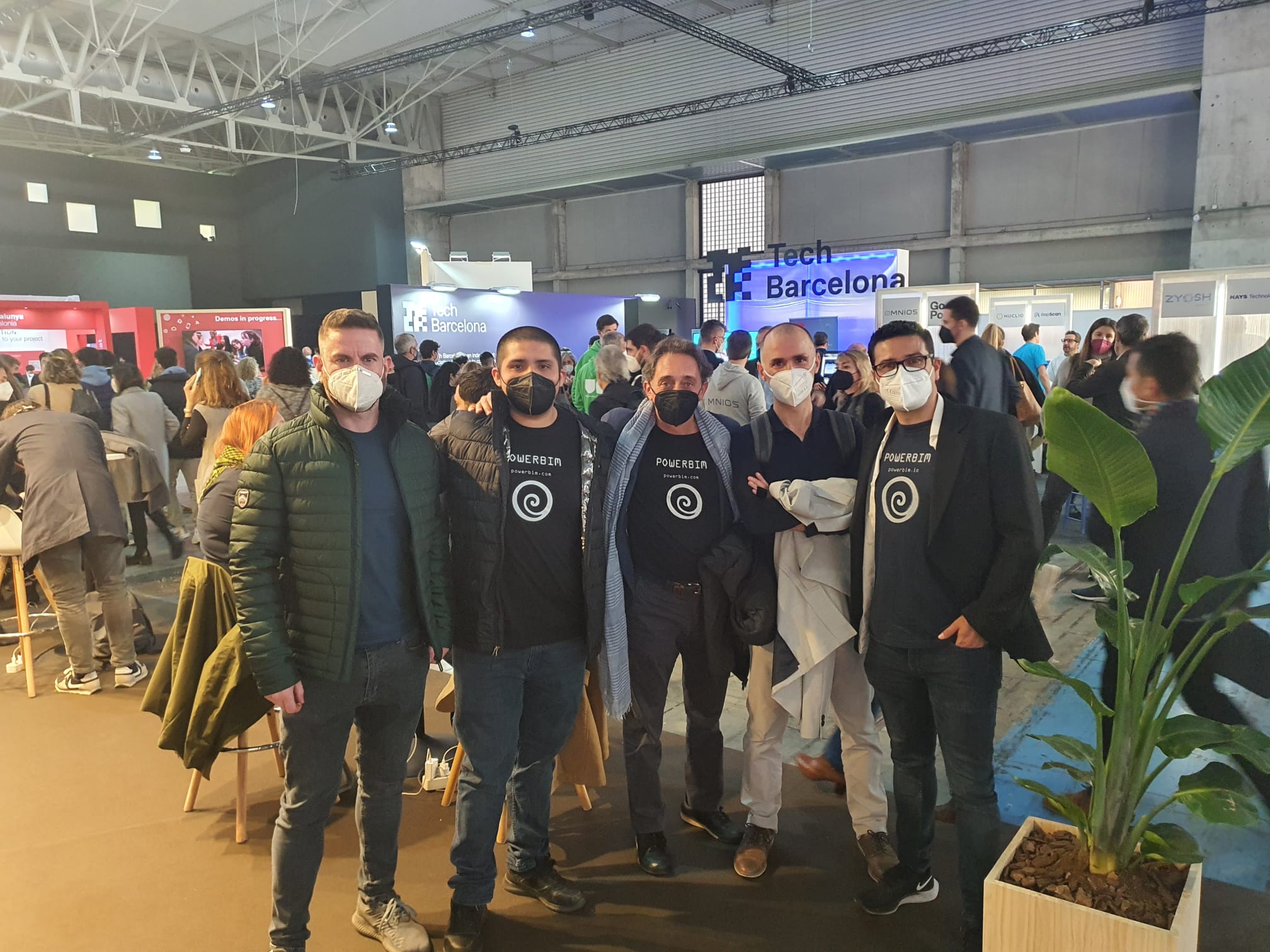
Publication in Building Smart Spanish Chapter – DIGITALTWINS
APPROACH TO THE DIGITAL TWIN FOR THE AECO SECTOR, BEYOND BIM
Authors: Fernando Morales, Frederic Gil, Gonzalo Garriga, Efren Garcia, Juan Ruiz, Brandon Quiroz
In this article we want to help with the correct definition of what a digital twin is from an evolutionary point of view, since its standardization and evolution is booming today, and specifically the application of digital twins on our AECO sector.
1. INTRODUCTION
What is a Digital Twin? We are in an exciting moment where we see in real time how the rise of a new technology is being defined and brewing. In reality, it is not that new, but it is as it usually happens in many cases, a concept that already existed with success stories within the reach of very few, such as NASA itself, which is becoming less exclusive in its evolution. But now is the time when we have a perfect storm that makes us go in 1 year (before the COVID 19 pandemic until today) to talk about digital twins as something new but distant and whimsical, to something that is of urgent need to address and implement. The big technological multinationals take positions, but this new paradigm shift is so important that there are neutral grounds where these organizations, together with entities from multiple fields, governments, public bodies, research centres and start-ups that have a lot to say on the subject, we put ourselves agreed to standardize and accelerate the emergence of the era of digital twins.
But what is and what is not a digital twin? Or more importantly, what is it for and who will use it? We will try to give our vision on the matter and how in BIM6D we are getting to have an interesting approach in our opinion, and that is that the digital twin is destined to completely renew our sector with prosperity, thanks to the adoption of digitization as an agent of change and connecting our sector with others in a transversal way. In fact, we dare to say that the extensive use of digital twins will bring with it a new evolutionary era at all levels, the closest thing to a new Renaissance movement because, as in the Quattrocento, multiple cultural, economic and thought aspects converge, and there will be certain “patrons” who will value new techniques, in their day the perspective, mathematics and geometry that were beginning to be applied to art, but also architecture, then brought a breath of fresh air and a new form to see what surrounds us. Well, saving the distances, once again the applied technique converges in a different and disruptive way, a few precursors that will serve as a reference, but at the end of the day a movement that will spread strongly and from which we will all benefit.
Before starting with our brushstrokes on the matter, we can advance that the Digital Twin is traveling a path in its implementation that is aimed at society itself, based on information technology applied in multiple formats and layers of depth and relationships, whose Its scope is global, although it begins with very specific success stories and partial development, it will be extended to the level of neighbourhoods, cities and the political territory itself, but for this it is necessary to join the path that other countries have already taken as soon as possible. started to roam.
Another characteristic of the digital twin is its ability to capture the attention and interest of users, and this is thanks to the power of data visualization and the integrated use of digitization as a dynamic agent, we have discovered that the complex becomes a lot simpler and more attractive for any user if the information is integrated on the virtual representation of what it represents and what it acts on, and as an example we did not want to miss the opportunity to prepare a small demo that illustrates what we are talking about:
with Autodesk Forge by our team at BIM6D, represents a piece of an interconnected smart city, where multiple productive sectors and commonly used by citizens are monitored in real time and available at the service of the user, who could consume this data depending on your profile of needs, or serve for strategic decision-making by the authorities in the long or short term, such as acting on multiple emergency services and taking actions for the safety of people if an incident is triggered , or in the longer term, make urban regeneration decisions more effectively to enhance certain socio-economic aspects.
With the digital twin we will be able to anticipate the future based on the crossing and advanced calculation of Big Data, which is the direct consequence of the digitization that is already taking place in all sectors, the key is to integrate them all, control them in a unified way and provide them with tools that make the information accessible and usable, the more people and organizations the better, and for that we must work the art of apparent simplicity over the complex.
2. HISTORY
Surely one of the first most relevant use cases of the digital twin, without calling it that, has been carried out by NASA in its first steps towards space exploration in 1960, where they first experimented with “pairing technologies”, a predecessor term of the digital twin, but that allowed NASA engineers to save the Apollo 13 mission.
But the first time we see the term used has been in David Gelernter’s book “Mirror Worlds” from 1991 (1), where he describes a future where he anticipates that people will see reality through a computer screen. Later, in 2002, Michael Grieves (2) from the Florida Institute of Technology applied the concept of the digital twin in the manufacturing sector where he proposed the digital twin as a conceptual model for product life cycle management (PLM).
The concept, as is often the case, materialized under different names before John Vickers of NASA rescued again the finished “digital twin” in 2010. Today, NASA uses digital twins to develop new recommendation systems, sheets of route and the control and management of “new generation” unmanned, land and air vehicles.
After a decade, the term digital twin has been applied in a wide range of uses and industries such as architecture, engineering, manufacturing, healthcare, mobility, aeronautics, etc.
 Mission Control Center, Houston (fuente: NASA, 1965)
Mission Control Center, Houston (fuente: NASA, 1965)
3. CURRENT REFERENCES
The digital twin is becoming one of the most important technologies due to its potential to improve the behaviour of systems, processes and services, through the monitoring, remote control and simulation of any type of asset, but what exactly is a digital twin? Some of the most prestigious organizations working on the standardization of digital twin technologies already have their own definitions and considerations:
“A digital twin is a representation of real-world entities and their processes, synchronized with a certain frequency and fidelity” (Digital Twin Consortium)
“A digital twin (DT) – also referred to as digital shadow, digital replica, or digital mirror – is a digital representation of a physical asset. Linked to each other, the physical and digital twin regularly exchange data through the PBOD (Performance-Based-Optimum-Design) lifecycle and use phase. Technologies such as artificial intelligence, machine learning, sensors and the Internet of Things (IoT) allow data collection and exchange to take place at the right time. ” (Building Smart International)
“Unlike static data models, digital twins are dynamic,” living “entities that evolve in real time. They learn, update, and communicate with their physical counterparts by exchanging data throughout the asset lifecycle using artificial intelligence, machine learning, and IoT technologies. Armed with these dynamic simulations, users of these virtual twins can fix problems before they happen, explore new opportunities and plan for the future. ” (Autodesk)
“A digital twin is a virtual representation of an object or system that spans its life cycle, is updated through the use of real-time data, and uses simulations, machine learning, and reasonable aid to help make decisions” (IBM)
“The ultimate vision of the digital twin is to create, test and build our equipment in a virtual environment” (John Vickers, NASA)
4. DIGITAL TWIN IN AECO
Continuing with the appointments to large organizations immersed in the standardization of the digital twin, but in this case about our sector, we would like to highlight two in particular:
“A digital twin combines data that describes the physical in digital form. Within the construction sector, a digital twin is a realistic representation of assets, their processes and systems” (Digital Built Britain)
And finally, a Microsoft graphic that was shown in one of the dissemination sessions at the Digital Twin Consortium, an organization of which we have been members since 2020, where it explains the life cycle of assets from the point of view of data type that are exploited throughout the asset’s life cycle:
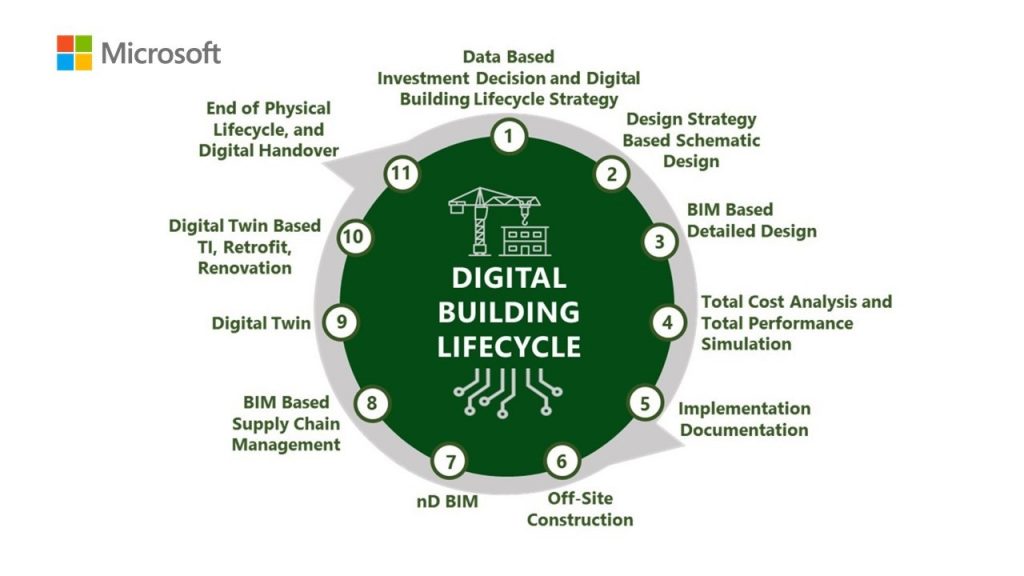
Data life cycle in the construction sector. (Source: Salla Eckhard, Microsoft, 2019) (3)
This graph represents a common data environment (CDE) used in the life cycle of projects whose utility consists in “discovering” (interesting term) the most efficient methodology in resources (economic and material) to deconstruct the physical asset and return it to rebuild and renew to be more efficient until the end of its life cycle. If you look at points 9, 10 and 11, the digital twin is not an end in itself, but is used to introduce improvements, renew the asset and improve its processes and this is thanks to real-time simulations on it. physical asset and the power to develop a strategy of cause-effect interventions, to achieve this objective and extend and improve its behaviour.
And for all this, in BIM6D we do nothing but surprise ourselves in part because from our origins, back in 2015, without knowing this denomination of digital twin but other related ones, our vocation without knowing it was to work in this line from the first moment , our own name and brand, BIM6D Consulting & Performance, was aimed at developing digitization services and products aimed at improving the behaviour of assets throughout their life cycle (building performance) based on the creation of digital models, management of the information and simulations that we soon discovered that they were not limited to energy, but organizing and structuring the databases of the life cycle by dimensions (dimensions of BIM relative to multiple uses of digital twins) and where the sixth dimension is the more ambitious in terms of data exploitation, because to improve the behaviour of assets we cannot limit ourselves to static data s, but we have to work with hourly or even higher frequency data, analyse multiple variables that influence the behaviour of assets, and integrate in an automated way the results of certain simulation and calculation software on digital models. Well, we are on the right path towards the so-called “Level 3” where we will work in the cloud with digital twins dedicated to improving the behaviour of the asset and where in the famous graph of maturity levels from CAD to BIM, at “Level 3” a see who dares, we have to replace the word iBIM with “DIGITAL TWIN“:

BIM maturity levels 1-4 (BSI, 2013)
We therefore see that for us the digital twin with respect to BIM is not a substitute, it is an evolutionary advance in the level of maturity of a digital transformation, so that neither CAD nor BIM will disappear, but we will go further thanks to the adoption of this new technology.
For us, then, a digital twin, today (which will certainly not be the same in a few years) the digital twin for AECO that we can already put into practice is defined as:
“A digital ecosystem that integrates existing technologies dedicated to the management and improvement of the behaviour of assets, which automatically process data that comes from the real asset such as sensors, asset management systems and maintenance (BMS, EMS, CMMS, Scada, etc. ), resource and business managers (ERP, CRM) and other platforms, and that are integrated with a common data environment (CDE) so that we can represent data analytics in a synchronized way on BIM, GIS and other digital environments, operate from the cloud and offer multiplatform applications to remotely manage assets (mobile, web, VR, AR, etc.). So that the difference between this digital ecosystem and the digital twin is the ability to simulate and predict the future of the systems and processes it manages, through the use of Big Data and artificial intelligence and thus be able to make decisions in real time based on the information obtained”.
And what is not a digital twin? Well, with these definitions, BIM models are not digital twins, we even know that without BIM there were already digital twins, what happens is that in our sector it makes a lot of sense to make BIM the stone angle that serves as a collaborative environment in the first place and as a receiver of that information for its location and easy understanding, but it is not the only piece of a digital twin at all. In the same way, the IoT, or the BMS or CMMS systems themselves are not either, since they analyse specific aspects more or less efficiently but the magic of the digital twin consists of crossing multiple processes that did not interact with each other, so that If we have an integrating platform for this, and we automatically analyse such amount of information, we can “discover” (the term used by Microsoft due to the capabilities of Big Data data services called “Data Discovery“) patterns behaviour based on rules, receive notifications when the KPI (Key Performance Indicator) exceed predefined thresholds and be able to act on devices and systems remotely, among other functionalities.
In BIM6D this digital ecosystem has a name in the form of a product: POWERBIM, whose infographic that summarizes at a glance how the functions (uses) and databases that it manages are organized are shown below:
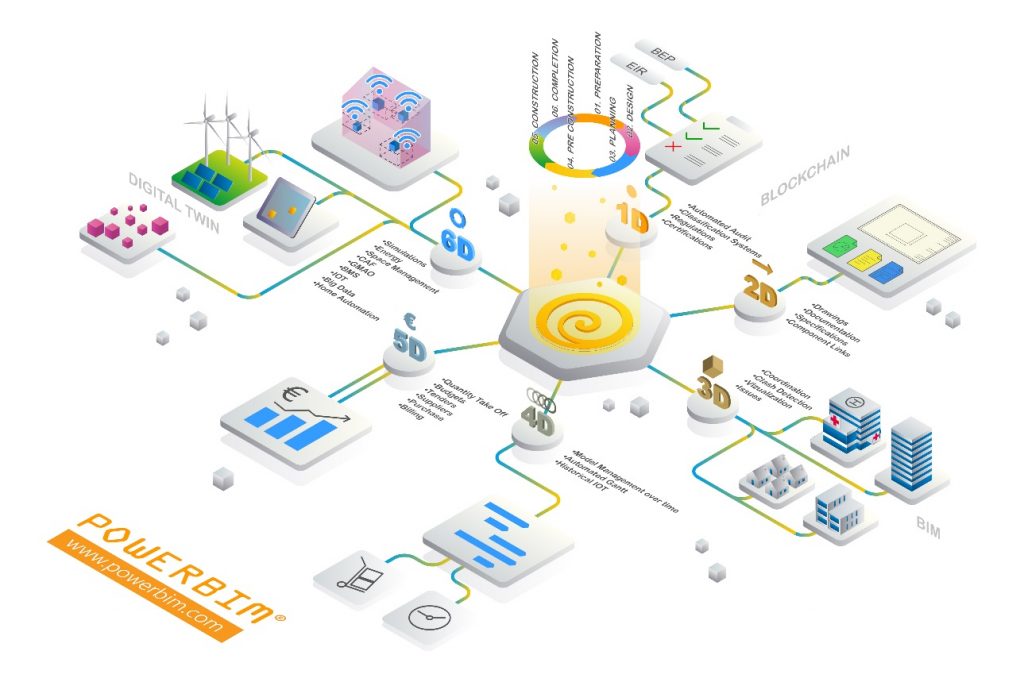
POWERBIM infographic, digital twin ecosystem (BIM6D Consulting & Performance, 2019) (4)
To conclude the definitions chapter, it should be noted that first of all the digital twin for AECO will be applied in certain use cases, building typologies, and will be used by certain professionals for asset management, but we will have to learn to evolve this technology and connect it to more and more productive sectors and with the city, to finally provide an end user, the data consumer who is the citizen, an intuitive and friendly interface, easy to use and access to information about this environment, therefore the digital twins must be scalable and multisectoral. Smart cities that integrate smart buildings and infrastructures, where other sectors such as mobility, services, and the smart devices (IoT) themselves that are already beginning to form part of our lives converge.
5. CASE STUDIES
One of the first steps when approaching the implementation of this technology, as with BIM, is to ask the client or end user what it is intended to be used for, have a clear digitization strategy and develop protocols, business plans, a roadmap that defines those uses, in addition to everything necessary to make that end possible, based on recognized standards as far as possible, but above all, based on the real needs of that client, organization or project concrete, and for this, innovation and R&D come into play more than ever as a fundamental part of any technological implementation. There are standards that should serve as a reference, but there will never be two equal projects, and we must innovate to find disruptive solutions that energize a business and go beyond the originally planned objectives of rigor.
In our own R&D, which constitutes the great investment that our company makes, we have already identified certain use cases that we show below, but that is undoubtedly a list that falls short of everything we can do with digital twins. We call this list “What can we do with a digital twin”:
- Audit databases of BIM models and out of BIM models based on rules based on regulations or information exchange requirements of a project (EIR)
- Integrate on a multiple BIM digital model project documentation (plans, reports, reports, specifications) at the project level, at the component level, areas or groups of components, making the digital models receivers of that localized information
- Generate data visualization reports (business intelligence) automatically based on templates, these templates search for certain project data in BIM-GIS models (virtual environment) and other connected systems (BMS, CMMS, EMS, IoT – physical environment), the result is to be able to have multiple dashboards that interact on the digital model and, therefore, on the physical asset they represent.
- Visualize data in multiple ways to get a better understanding of them, static data, real-time data, historical data, aggregated, comparative, simulated, predictive data, data represented in heat maps on the digital model or in graphs of so that we can make multiple filters of the information and categorize it at different levels.
- Manage project costs in an integrated way, involving all agents who make decisions about tenders, cost studies, budgets, contracting services and purchases. Ultimately being able to control in real time everything that affects the cost and business of an asset.
- Act on the systems and devices connected from the digital twin, of special relevance since the pandemic, which will undoubtedly lead us to connect the digital twin not only with fixed or portable devices such as sensors or cameras, but also to control drones to remote inspection, robotic arms and more or less autonomous remote-controlled robots. An exciting near future is approaching for the industry.
- Manage the life cycle of assets, from their design, construction phase to the use and operations phase, to the maintenance and management of the asset, which will result in data that will be the key to improving production processes and industrializing construction with prefabricated techniques, use of recyclable materials and efficient waste management, as well as better management of the systems and services that are developed.
- Manage renewable energy production systems, storage, management and injection to the grid to help generate smart energy grids systems (smart-grids) to achieve alignment with European directives (Green Deal) and renew the building stock in a way that is more efficient and sustainable.
To these cases a greater complexity is added if possible, that any of them acts differently depending on the type of building and infrastructure that we act, or the technical discipline, and of course, the phase in which we act.
 Some POWERBIM digital twin use cases (BIM6D, 2018-2021)
Some POWERBIM digital twin use cases (BIM6D, 2018-2021)
6. GLOBAL PURPOSES OF THE DIGITAL TWIN
Since the declaration of a pandemic by COVID-19 around the world in 2020, it is necessary to redesign the near future, and put the current use of data in crisis. Growth trends in certain areas have fallen to the benefit of others, and essential sectors regain their importance such as health without going any further. We are in a new world where technological and digital development is accelerating and the digital twin will help society as an emerging technology to provide the best possible answers to a series of growing problems that we have to face from today.
The digital twin is not only a virtual model of a thing or a process, but it may be that of the people themselves or of a geopolitical territory and its socio-economic reality, so that we will see current situations represented, but also visualize possible future scenarios for make better decisions.
This is well known at the “CDBB – Centre for Digital Built Britain”, an organization that has been running the National Digital Twin (NDTp) program for a few years now (5), a partnership between the University of Cambridge and the Department of Business, Energy and UK Industrial Strategy. For this working group, “high-quality and secure data improves the way any infrastructure is built, managed, operated, and eventually dismantled.” They carry out their work in improving the efficiency in the capture and treatment of data to generate savings for the interested parties and guarantee social benefits for all. One of the goals of the NDTp is to enable a national digital twin, that is, “an ecosystem of connected digital twins to foster better outcomes from our built environment.”
In one of the possible use cases, it is stated that, if an explosion is generated in an office building, the national digital twin can immediately cut the nearby metro for security reasons, activate the evacuation of buildings in the area and notify to the health services with preference for the use of the streets and to be able to deploy the entire emergency system in real time, faster and more efficiently than up to now.
Finally, we would like to end this article by highlighting the importance of incorporating all technology, such as the digital twin that concerns us, with a positive global purpose, and this must be done from the institutions. Such deployment of technical means, injections of large capital such as the one that is already being produced, public and private, makes no sense if the benefit is applied only to the project itself or to the client who orders that technology, which of course must be to benefit and increase the value of its assets that are managed in this way, the improvement in certain indicators that respond to global positive purposes must be incorporated as necessary, which in our point of view, we list the most important on which the digital twin should influence:
- the fight against climate change by monitoring and improving certain indicators of energy efficiency, carbon footprint and environmental impact
- the contribution to the health and well-being of citizens, monitoring and managing indicators of people’s health, and making the relationship between the health sector and citizens more direct thanks to digitization.
- safe and open access to relevant information by all citizens, in real time, strengthening cybersecurity and accessibility to that information.
- the creation of new technological business models, therefore, favouring the creation of multiple ICT companies and jobs, thanks to the connection of new services associated with the digital twins.
Along these lines, at BIM6D we are venturing to interpret this digital twin for positive global purposes, on a community scale, and attacking certain strategic indicators that will be key to incorporate so that we can have a better future as a society.
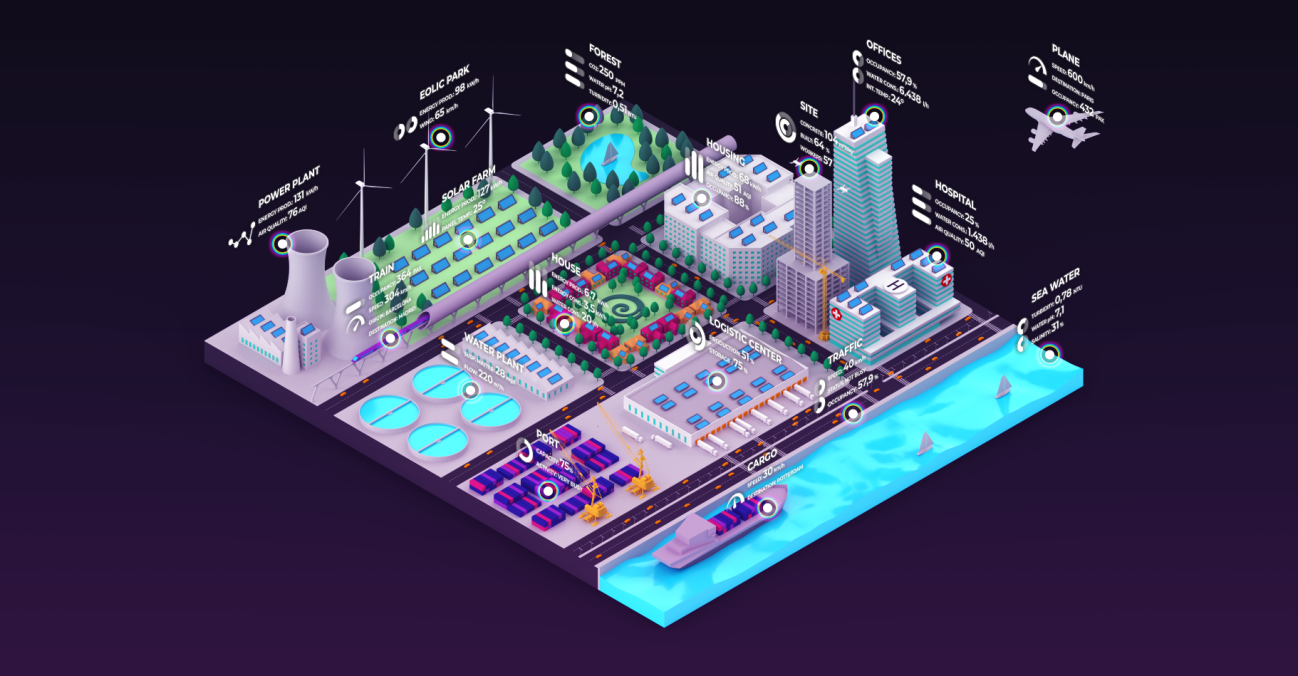
References:
- Gelernter, David Hillel (1991). Mirror Worlds: or the day the software puts the universe in a shoe box – how it will happen and what it will mean. Oxford; New York: Oxford University Press
- Grieves, M., Virtually Intelligent Product Systems: Digital and Physical Twins, in Complex Systems Engineering: Theory and Practice, S. Flumerfelt, et al., Editors. 2019, American Institute of Aeronautics and Astronautics
- https://www.linkedin.com/pulse/digital-building-lifecycle-twins-salla-eckhardt/?trackingId=qQVW5ooDgHE5QfAm3zRfFQ%3D%3D
- https://powerbim.com/
- https://www.cdbb.cam.ac.uk/what-we-do/national-digital-twin-programme
MEET A FORGE SYSTEM INTEGRATOR – BIM6D
BIM6D Consulting & Performance team and scope of works presentation in the Autodesk Forge blog “Meet a Forge System Integrators” program.
It has been a great pleasure to present ourselves and to show 3 disruptive technological projects in where we are inolved thanks to this amazing technology that we are using to integrate BIM to multiple systems for our clients in AECO sector.
We presented our work with the innovation department in Zalando by Gonzalo Garriga. Our work for smart green buildings and cities using AI by Frederic Gil and Fernando Morales, CEO and director of BIM6D, presenting the work with ENNE Gestión for Servei Català de la Salut with POWERBIM for remote inspection for 2 covid hospitals in Catalonia.
Thanks to the multidisciplinary character and the great effort of our team over this years we are being reference in digitalization for the sector and thanks to Autodesk to have this great opportunity to present us in the SI program
Do you need to start working with Forge in your projects just to explore new challenges in bim ? Just contact us
Publication in ABC newspaper – Smart Buildings and grids
Join us to the Smart and Green Revolution !
New 4.0 Engineering business area led by Frederic Gil Banus
New Marketing and Business Management unit led by Efren Garcia Fernandez
ABC newsletter has published a column about Smart Buildings including the vision of opportunies in the sector in this area to BIM6D approach by developing digital twins tools and 4.0 engineering services in orther to evolve to Smart Buildings and Smart Cities integrated.
The today’s opportunity, from today to 2030, to evolve in digitalization, innovation and to adapt the construction sector in Spain to actual disruption changes, taking profit of our capabilities, prestige and competitiveness is unique. We call “New Smart and Green Revolution!”
Fernando Morales, founder of BIM6D, has created a team of professionals in the sector and high-level IT developers, and they have bet to digitalize buildings and their systems based in BIM methodology and their tools. First developing services for digitalization and simulation of multiple projects of Smart Buildings, while at the same time they have developed a digital platform – PowerBIM – which integrates digital models to Smart Buildings and Smart Grids data to monitor and to manage their systems in remote. This is the basis of their actual development of an ecosystem of Digital Twin – PowerTwin – in which, trough simulations, IoT, artificial intelligence, virtual and augmented reality convert in more smart the platform and allow to predict and to optimize the different systems.
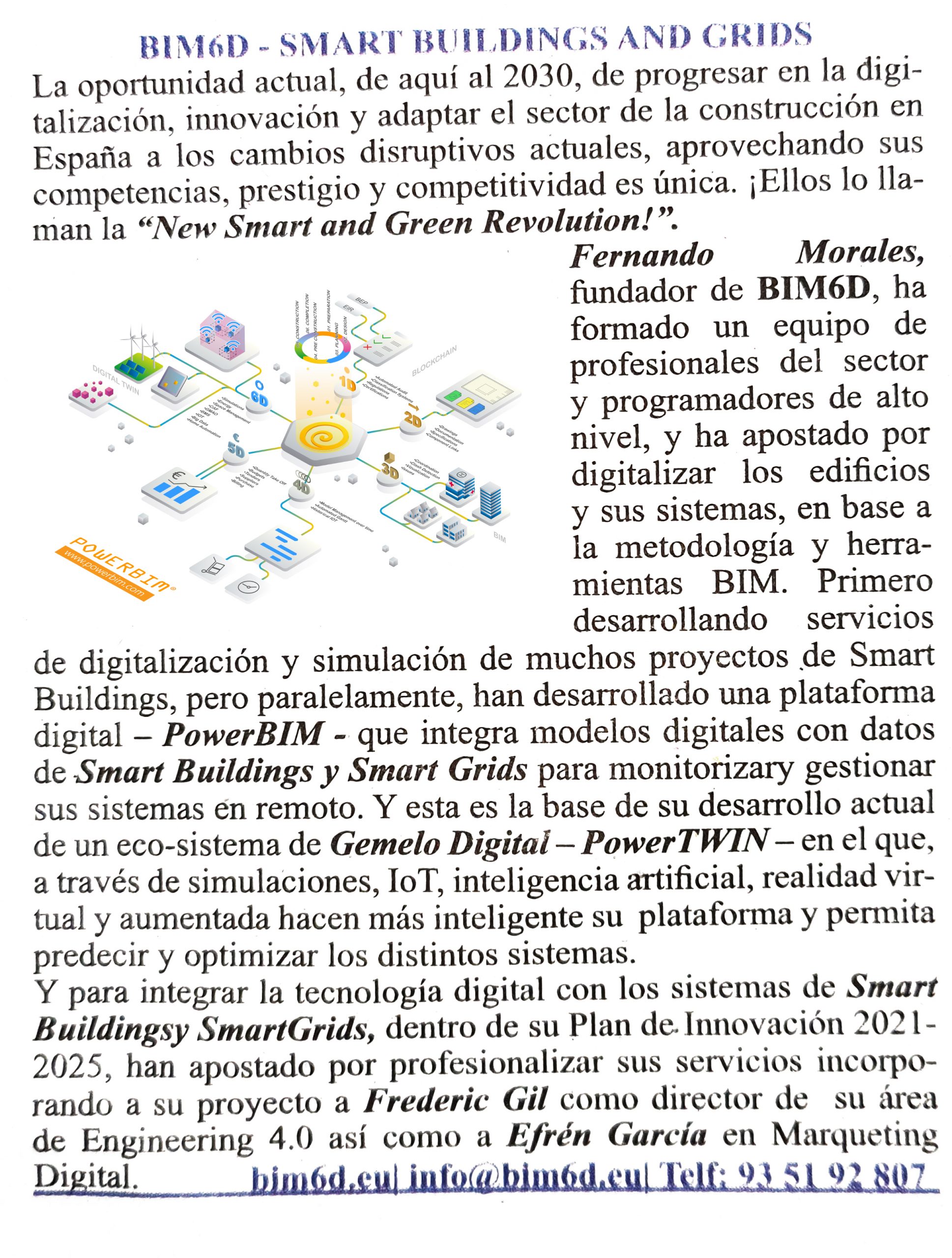
FORGE PARTNER TALKS – FACILITY MANAGEMENT AND LOGISTICS
Zalando representant of Corporate Real State Innovation Department, Analhia Cano, acces to participate in the Autodesk Forge Partner Talks “Winter Sessions” dedicated to Facility Management and Logistics, giving their vision of the work of BIM6D and POWERBIM for their interests.
POWERBIM is the tool that Zalando selected for BIM Construction and Facility Management purposees, from BIM Audit tools that automatically create data reports from BEP compliance, to Clashdetection data results integration, to CAFM data integration in BIM, until Logistic Identification, all is about DATA integrated to BIM to better understand the complexity of Warehouse Logistic Centers.
